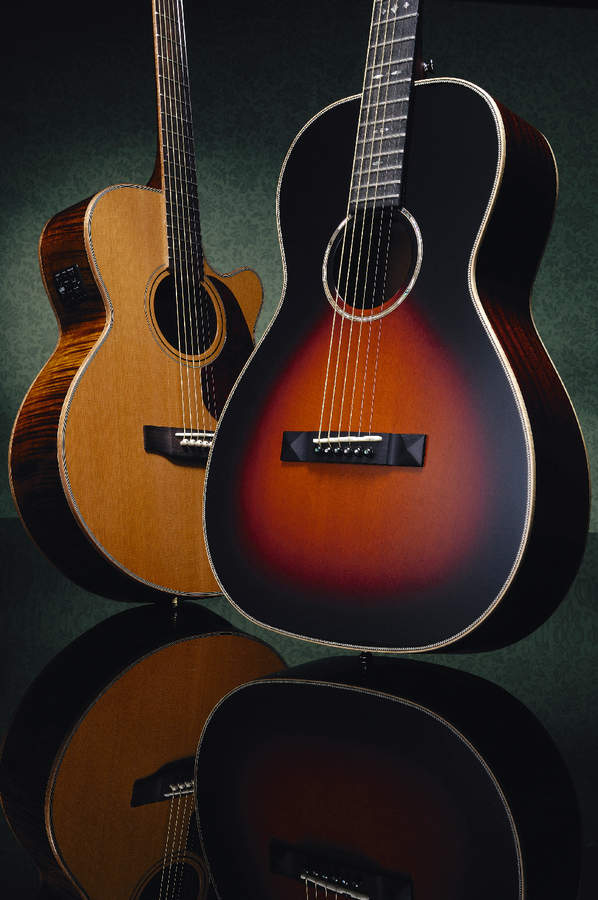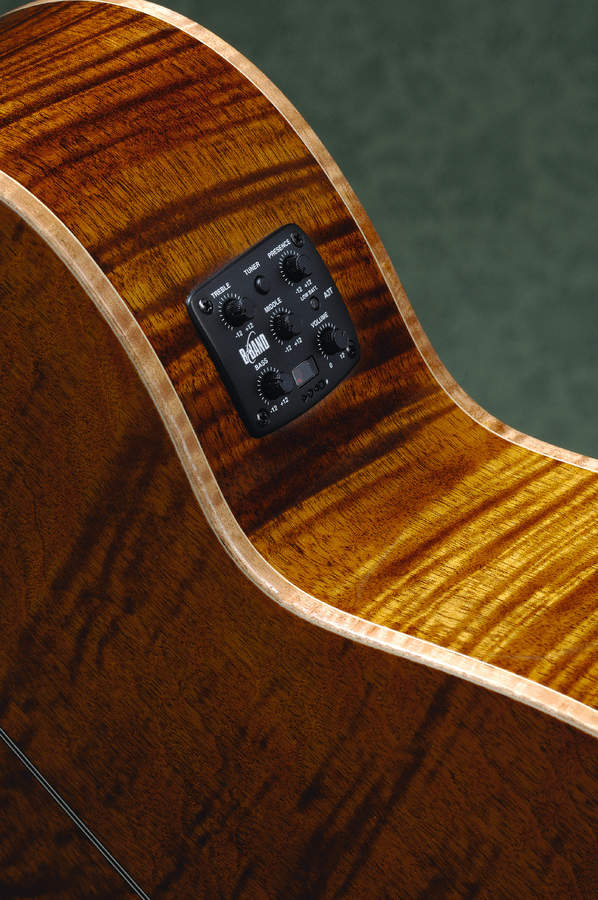MusicRadar Verdict
Despite any reservations, this could sell on the figured mahogany back and sides alone.
Pros
- +
Sumptuous build and cosmetics; excellent B-Band preamp.
Cons
- -
Under-saddle output imbalance; acoustic sound needs more warmth.
MusicRadar's got your back

Hudson's Firefly (left) and Little Wing (right).

Flamed mahogany with maple binding make for a striking, upmarket look.
The range includes budget boxes, but the main spotlight is on the much more upmarket Vintage Evolution series and the newly launched Lightning Tree series, both apparently sourced from the same Chinese factory as Guild's GAD acoustics.
The central reason is that though the cedar front is solid, the back and sides are laminated. But goodness, what a visual treat it is - bookmatched, richly figured mahogany, bound top and back in coachlined maple and shimmering under a spankingly lustrous finish.
The laminates aren't stinted on either, because the innermost plies display some flaming too, and the guitar's whole presentation, which includes maple neck and headstock binding and a set of enclosed, gold Kluson-style tuners with butterbean knobs, is pretty much flawless. A second strap button is again fitted, this time on the heel cap.
Though span across the octave and string spacing at the nut and bridge are identical to the parlour's, the gloss-finished neck feels a very different affair - and not just because of its slimmer 43mm nut width, longer scale length and 14th fret neck join.
It's mainly down to the profile which, rather than 'V'-profiled, is shallow with a flattish back, endowing a slick, almost electric-like grip - an impression emphasised by our sample's slinky, buzz-free action. The neck's shallowness also gives it an airier feel than it actually measures, which incidentally is no bad deception.
The Firefly's preamp is B-Band's A3T, an update of its A3.2 unit and incorporating a chromatic tuner. This is neatly shoehorned into the compact control plate, and in addition to the note LCD read-out and below/on-pitch/above indicators there's an extra LED for referencing semitones.
It's accurate if a slight strain to see and, handily, the tuner can be used without the guitar needing to be plugged in - not always so with onboard tuners. In other respects, the layout is the same as the A3.2's, offering a five-on-a-dice pattern of rotaries for four-band EQ and volume.
Sounds
The Firefly initially sounds a little uninvolving, though like its neck width, this is deceptive to an extent. In fact it has a reasonable 000-league projection with pleasant clarity and a chimey sustain.
The one negative is a slightly brittle tonality which not only sits at odds with the theoretically warmth-contributing cedar top but tends to lend a hint of wiriness to the sound that is more maple-like than mahogany.
Want all the hottest music and gear news, reviews, deals, features and more, direct to your inbox? Sign up here.
Fired up, however, the B-Band's inherently natural voicing and smoothly responsive EQ allow the guitar's personality to be adapted pretty much at will.
Yes, things can head towards high-end overkill via heavy-handed treble and presence settings, but equally these bands can be sympathetically reined back - alongside dialling in bass and a soupcon of mid-range to taste - to create the kind of warmth and fluidity that isn't evident acoustically.
The only aspect spoiling the powered party is our sample's dominant low E, but that's down to the pickup set-up and string imbalances that, though pretty easily rectifiable, are annoyingly common on under-saddle systems.
We've heard richer sounding folks than the Firefly, but assessed purely as an electro - and aside from its iffy under-saddle balance - it puts up a fine showing. It's also a damned handsome guitar in a plush kind of way.
The HO-1W Little Wing, meanwhile, is a work in progress. 'Wide neck' needs to mean what it says and until that's taken care of, as promised, hardline fingerstylists won't be flocking to buy.
The rest of us might, though, because in other respects, particularly sound, it's one of the most enjoyable parlours out there for the money.